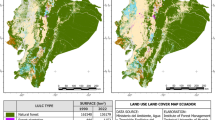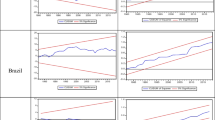Abstract
The OLG-model analyzes emissions of an accumulative pollutant in a laissez-faire economy and an economy regulated through a government controlled license market. The government either takes the price on the license market as given or sells the licenses demanded at the Cournot price. The first type of regulation is called a 'liberal environmental policy', and the second type a 'monopolistic environmental policy'. The forward looking temporary and the stationary equilibria as well as the pollution boundaries of the mechanisms are studied. If people can choose between laissez-faire and regulation (or between the liberal and the monopolistic environmental policy regime), then in general no steady state exists. Instead endogenous policy cycles can alternate between laissez-faire and regulation or between liberal and monopolistic regulation.
Similar content being viewed by others
References
Azariadis, C. (1993), Intertemporal Macroeconomics, Oxford.
Blanchard, O. J. and S. Fischer (1989), Lectures on Macroeconomics, Cambridge.
Brock, W. A. (1973), 'A Polluted Golden Age', in V. L. Smith, ed., Economics of Natural and Environmental Resources.
Burton, P. S. (1993), 'Intertemporal Preferences and Intergenerational Equity Considerations in Optimal Resources Harvesting', Journal of Environmental Economics Management 24, 119–132.
Diamond, P. A. (1965), 'National Debt in a Neoclassical Growth Model', American Economic Review 55, 1126–1150.
Howarth, R. B. and R. B. Norgaard (1990), 'Intergenerational Resource Rights, Efficiency, and Social Optimality', Land Economics 66, 1–11.
Howarth, R. B. and R. B. Norgaard (1992), 'Environmental Valuation under Sustainable Development', American Economic Review 82, 473–477.
Howarth, R. B. and R. B. Norgaard (1995), 'Intergenerational Choices under Global Environmental Change', in D. W. Bromley, ed., The Handbook of Environmental Economics, Cambridge, MA.
Hultkrantz, L. (1991), 'Forestry and the Bequest Motive', Journal of Environmental Economics Management 22, 164–177.
John A. and R. Pecchenino (1994), 'An Overlapping Generations Model of Growth and the Environment', Economic Journal 104, 1393–1410.
John A., R. Pecchenino, D. Schimmelpfennig and S. Schreft (1995), 'Short-lived Agents and the Long-lived Environment', Journal of Public Economics 58, 127–141.
Kemp, M. C. and N. V. Long (1980), 'The Underexploitation of Natural Resources: A Model with Overlapping Generations', in M. C. Kempand N. V. Long, eds., Exhaustible Resources, Optimality and Trade, Amsterdam.
Lines, M. (1995), 'Dynamics and Uncertainty', in H. Folmer, H. L. Gabel and H. Opschoor, eds., Principles of Environmental and Resource Economics, Aldershot.
Löfgren, K. G. (1991), 'Another Reconciliation Between Economists and Forestry Experts: OLG-arguments', Environmental and Resource Economics 77, 95–111.
Nordhaus, W. D. (1991a), 'To Slow or Not to Slow: The Economics of the Greenhouse Effect', Economic Journal 101, 920–937.
Nordhause, W. D. (1991b), 'Economic Approaches to Greenhouse Warming', in R. Dornbusch and J. M. Poterba, eds., Global Warming, Economic Policy Responses, Cambridge.
OECD (1994), The Economics of Climate Change.
Samuelson, P. A. (1958), 'An Exact Consumption-Loan Model of Interest with or without the Social Contrivance of Money', Journal of Political Economy 66, 467–482.
Tietenberg, T. (1985), Emissions Trading: An Exercise in Reforming Pollution Policy, Washington.
UNEP (1997), Global Environmental Outlook1, Oxford.
Uzawa, H. (1991), 'Global Warming Initiatives: The Pacific Rim', in R. Dornbusch and J. M. Poterba, eds., Global Warming, Economic Policy Responses, Cambridge.
Wagner, T. (1997), 'Dauerhafte öffentliche (Un) Güter: Ist eine myopische Regulierung von CO2-Emissionen besser als keine?', Jahrbücher für Nationalökonomie und Statistik 216/1, 92–112.
Author information
Authors and Affiliations
Rights and permissions
About this article
Cite this article
Wagner, T. Limits and Cycles of Environmental Policy. Environmental and Resource Economics 11, 155–175 (1998). https://doi.org/10.1023/A:1008218114525
Issue Date:
DOI: https://doi.org/10.1023/A:1008218114525




